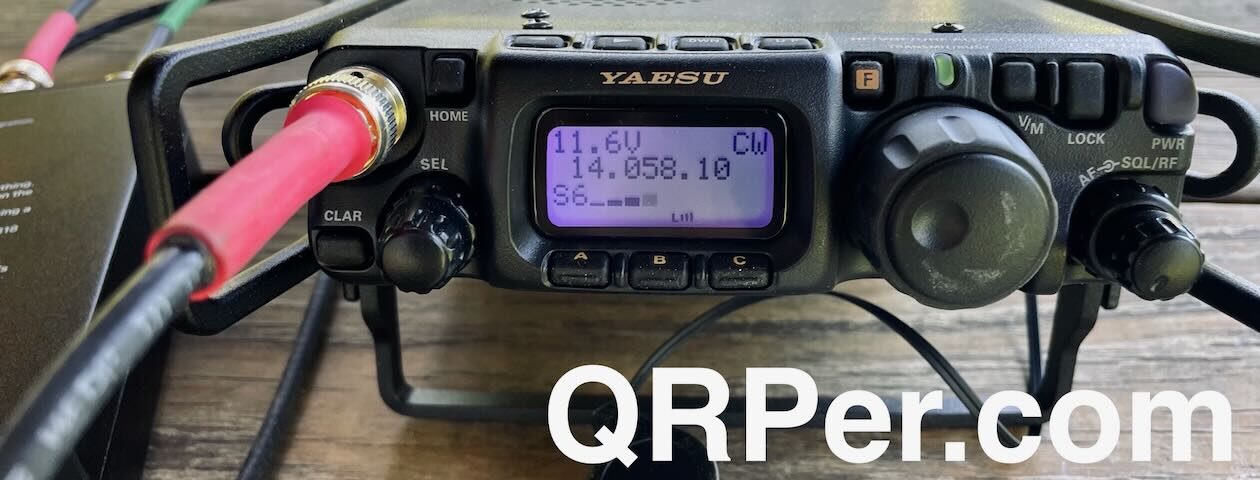
Many thanks to Dave (K1SWL) who writes:
Comments on vehicle-mounted antennas
by Dave Benson (K1SWL)
As with Rand’s recent post about his effective vehicle setup, I and others also use a small operating table inside the vehicle. I’ve tried a number of approaches to antennas. Without elaborating on those schemes, I’ll note that winter is now closing in here in NH. As a result, I’m now operating exclusively from my truck. My interest is now in minimizing setup and tear-down times. Barry (WD4MSM)
also commented about the improvement in vehicle-mounted antennas with an added ground. I’d like to quantify that.
I’d recently ordered a number of Hustler Mobile antenna components. They’re used as a stationary-portable setup using that company’s high-quality mag-mount. As I first evaluated the antenna, I was disappointed to find the minimum SWRs to be on the high side.
 These results were related to the ‘floating’ coax shield, which serves as a counterpoise with the mag-mount setup. Worse yet, these results were inconsistent. Touching the coax connector shell at the antenna analyzer caused the SWR to jump up, as did just changing the way I held the analyzer. Bad juju! It means RF inside the vehicle, with the potential for RF-‘hot’ symptoms at the rig.. Adding a 1:1 balun inline eliminated the stray RF at the rig, but didn’t do much for the SWR. It’s also just one more gadget to bring along.
These results were related to the ‘floating’ coax shield, which serves as a counterpoise with the mag-mount setup. Worse yet, these results were inconsistent. Touching the coax connector shell at the antenna analyzer caused the SWR to jump up, as did just changing the way I held the analyzer. Bad juju! It means RF inside the vehicle, with the potential for RF-‘hot’ symptoms at the rig.. Adding a 1:1 balun inline eliminated the stray RF at the rig, but didn’t do much for the SWR. It’s also just one more gadget to bring along.
 A better fix was a custom bracket that bolted to the truck frame. I first confirmed that there was low-resistance continuity between a target location and the vehicle’s cigarette lighter shell. This was something of a ‘comedy of errors’. I had a sheet-metal angle bracket on hand and went to work enlarging a hole in it. This had the usual outcome: a drill bit grabbed the workpiece and spun it. The bracket itself was buckled beyond redemption and my finger’s now healing well. A length of 1-1/2 inch aluminum angle bracket was just the ticket. Note that the mounting hole needs to be offset from the coax fitting mount. This avoids an interference between the mounting bolt and coax connector shell. Ask me how I know. The bracket assembly uses a specialty coax fitting from DX Engineering. It’s their part number DXE-UHF-FDFB.
A better fix was a custom bracket that bolted to the truck frame. I first confirmed that there was low-resistance continuity between a target location and the vehicle’s cigarette lighter shell. This was something of a ‘comedy of errors’. I had a sheet-metal angle bracket on hand and went to work enlarging a hole in it. This had the usual outcome: a drill bit grabbed the workpiece and spun it. The bracket itself was buckled beyond redemption and my finger’s now healing well. A length of 1-1/2 inch aluminum angle bracket was just the ticket. Note that the mounting hole needs to be offset from the coax fitting mount. This avoids an interference between the mounting bolt and coax connector shell. Ask me how I know. The bracket assembly uses a specialty coax fitting from DX Engineering. It’s their part number DXE-UHF-FDFB.
This bracket is bolted down on one of the corners of the Tacoma’s passenger seat assemblies. It’s the closest location to the antenna I found without drilling holes and cutting the coax. For this vehicle, it’s a 10mm bolt and was paint-coated for appearance reasons. I replaced it with a stainless-steel bolt from a hardware store. It’s important to include a split-lockwasher between the bolt and the bracket. This’ll keep the conductivity to the frame good over time. The bracket is deburred and its corners rounded to preclude injury to passengers.
In any event, it’s out of the way of the seat’s legroom space. A 3-foot coax cable assembly brings the coax nicely up behind the rig atop the operating surface.
So- how’d it work? It’s like the difference between night and day! The broad SWR curves vanished – replaced by typical characteristics for monoband antennas. The sensitivity to handling the coax has vanished. (A representative curve at right.) The curves are narrower, and that’s actually a good sign- it means that unwanted resistances have been reduced.
With this fix in place, here are the SWR minima:
Frequency SWR
14060 1.04:1
21060 1.05:1
28060 1.16:1
 I took advantage of the CQ Worldwide CW Contest this past weekend. I was able to work 101 stations on 10M, 15M and 20M with this setup. That was from a State Park 5 minutes away. The attraction was a large and sunny parking lot, and solar gain was such that I needed to leave the truck door open several times. This area is kept plowed out in winter, and I may try for the POTA ‘kilo’ award from there at the 1000-contact benchmark.
I took advantage of the CQ Worldwide CW Contest this past weekend. I was able to work 101 stations on 10M, 15M and 20M with this setup. That was from a State Park 5 minutes away. The attraction was a large and sunny parking lot, and solar gain was such that I needed to leave the truck door open several times. This area is kept plowed out in winter, and I may try for the POTA ‘kilo’ award from there at the 1000-contact benchmark.
We’ll see…. 73, K1SWL

































